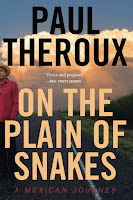This week, I have four more books from the remainder mills of HamiltonBook - I'm lumping these as Literary. Last week, I had the first four books from that big box; next week will see the last four.
Henry, Himself was Stewart O'Nan's new novel in 2019; it might still be his most recent book. It's loosely related to his previous novels Wish You Were Here and Emily, Alone. (I have copies of both of them but haven't read either; I've been a fan of all of the O'Nan books I've read without ever reading him fast enough to actually catch up.) This is a character-focused novel, and I think set in between the times of the previous two books - in 1998, when the title character (husband of the Emily who is Alone in her book) is seventy-five and apparently not long for this world. (How long are any of us for this world at seventy-five? Well, my wife has spent the last couple of years telling me about Gordon, a man of I think a hundred-and-three who she saw at the free-tax-prep-for-seniors office where she works in the spring, so that's where I've set my goals.)
Realistically, I'll want to read two fairly substantial novels before starting this one. I won't get to it any time soon, unless my reading life changes radically again. But who knows?
I probably had a copy of Francois Rabelais's Gargantua and Pantagruel before. I would not be surprised if it was this exact Everyman's Library edition - I like these books (though I tend to remove their dust jackets, so they can sit, mostly in nice red cloth, on my shelves and judge me for not reading them) and this edition is from 1994, so there's been plenty of time for copies to percolate around. This is a classic, obviously: a four-hundred-year-old translation of a five-hundred-year-old book, or maybe series of books. I've never read it; I hope to read it someday. Now I have a slightly higher chance of doing so.Another book from Everyman's, and I could say again most of what I just said: The Confessions of Jean-Jacques Rousseau. This one is only a one-hundred-year-old translation of a three-hundred-year-old book, but it's also French, which I didn't mention last paragraph.I don't quite know the Everyman's color scheme. As I said, most of the books I've had a red (maroon, maybe): those are mostly British novels. Confessions is dark green, perhaps for non-fiction? Gargantua is a light blue, which I guess is for Continental literature. Looking at my shelves, what I thought of as "red" seems to actually be two things: a dark maroon for 19th century British (and earlier?) and a lighter red for English-language stuff from the 20th century (including some Americans).
Last for this batch: the most recent travel book from Paul Theroux, 2019's On the Plain of Snakes. This one is a trip through Mexico, clearly inspired by all of the fear-mongering about "the border" in the years just prior and apparently spending a lot of its time following that border. My assumption is that Theroux has no truck at all for any of that fear-mongering, but he's getting up in years now, and who knows how a curmudgeon will land in his old age?I've never read a Theroux novel, but I'm basically caught up on his travel books: there are a few scattered ones from earlier in his career I haven't read, and the recent short-pieces collection Figures in a Landscape is on my shelves mocking me, but I have gotten through the big books from the prior two decades or so, up to Deep South.
These are probably not books I'll get to any time soon. But we all want stretch goals on our shelves, don't we?




No comments:
Post a Comment